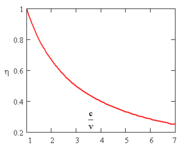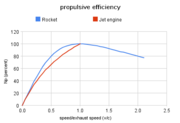
Propulsive efficiency
Encyclopedia
In aircraft
and rocket design, overall propulsive efficiency is the efficiency, in percent, with which the energy contained in a vehicle's propellant is converted into useful energy, to replace losses due to air drag, gravity, and acceleration. It can also be stated as the proportion of the mechanical energy actually used to propel the aircraft. It is always less than 100% because of kinetic energy loss to the exhaust, and less-than-ideal efficiency of the propulsive mechanism, whether a propeller
is the efficiency, in percent, with which the energy contained in a vehicle's propellant is converted into useful energy, to replace losses due to air drag, gravity, and acceleration. It can also be stated as the proportion of the mechanical energy actually used to propel the aircraft. It is always less than 100% because of kinetic energy loss to the exhaust, and less-than-ideal efficiency of the propulsive mechanism, whether a propeller
, a jet exhaust, or a fan. In addition, propulsive efficiency is greatly dependent on air density and airspeed.
Mathematically, it is represented as where
where  is the cycle efficiency and
is the cycle efficiency and  is the propulsive efficiency. The cycle efficiency, in percent, is the proportion of energy that can be derived from the energy source that is converted to mechanical energy by the engine
is the propulsive efficiency. The cycle efficiency, in percent, is the proportion of energy that can be derived from the energy source that is converted to mechanical energy by the engine
.
 For all airbreathing jet engine
For all airbreathing jet engine
s the propulsive efficiency (essentially energy efficiency
) is highest when the engine emits an exhaust jet at a speed that is the same as, or nearly the same as, the vehicle velocity. The exact formula for air-breathing engines as given in the literature, is

where c is the exhaust speed, and v is the speed of the aircraft.
A corollary of this is that, particularly in air breathing engines, it is more energy efficient to accelerate a large amount of air by a little bit than a small amount by a large amount, even though the thrust is the same. Note however, that duct jet engines give no thrust when the inlet and exhaust speeds are exactly the same.

 is usually high due to the high combustion temperatures and pressures, and long nozzle employed. The value varies slightly with altitude due to atmospheric pressure on the outside of the nozzle/engine, but can be up to 70%. Most of the remainder is lost as heat energy in the exhaust.
is usually high due to the high combustion temperatures and pressures, and long nozzle employed. The value varies slightly with altitude due to atmospheric pressure on the outside of the nozzle/engine, but can be up to 70%. Most of the remainder is lost as heat energy in the exhaust.
Rocket engines have a slightly different propulsive efficiency ( ) than airbreathing jet engines as the lack of intake air changes the form of the equation. This also means that rockets are able to exceed their exhaust velocity. See diagram.
) than airbreathing jet engines as the lack of intake air changes the form of the equation. This also means that rockets are able to exceed their exhaust velocity. See diagram.

As with ducted jet engines, matching the exhaust speed and the vehicle speed gives optimum efficiency in principle. Although in practice rocket exhausts are high and typically fixed, this can be a useful theoretical consideration. Unlike ducted engines, rockets give thrust even when the two speeds are equal.
Rockets often also have an additional significant source of energy, because they are able to leverage the kinetic energy of their propellant with the Oberth effect
. This is also a factor for air-breathing aircraft, but much smaller one due to their lower speed.
engines which rely on a propeller for propulsion since their output is typically expressed in terms of power rather than thrust. The equation for heat added per unit time, Q, can be adopted as follows:
where is engine output in horsepower
is engine output in horsepower
, converted to foot-pounds/second by multiplication by 550. Given that specific fuel consumption is Cp = h/Pe and using the aforementioned substitutions for H and J, the equation is simplified to:
expressed as a percentage.
Assuming a typical propulsive efficiency of 86% (for the optimal airspeed and air density conditions for the given propeller design), maximum overall propulsive efficiency is estimated as:
of 86% (for the optimal airspeed and air density conditions for the given propeller design), maximum overall propulsive efficiency is estimated as:
Aircraft
An aircraft is a vehicle that is able to fly by gaining support from the air, or, in general, the atmosphere of a planet. An aircraft counters the force of gravity by using either static lift or by using the dynamic lift of an airfoil, or in a few cases the downward thrust from jet engines.Although...
and rocket design, overall propulsive efficiency
 is the efficiency, in percent, with which the energy contained in a vehicle's propellant is converted into useful energy, to replace losses due to air drag, gravity, and acceleration. It can also be stated as the proportion of the mechanical energy actually used to propel the aircraft. It is always less than 100% because of kinetic energy loss to the exhaust, and less-than-ideal efficiency of the propulsive mechanism, whether a propeller
is the efficiency, in percent, with which the energy contained in a vehicle's propellant is converted into useful energy, to replace losses due to air drag, gravity, and acceleration. It can also be stated as the proportion of the mechanical energy actually used to propel the aircraft. It is always less than 100% because of kinetic energy loss to the exhaust, and less-than-ideal efficiency of the propulsive mechanism, whether a propellerPropeller (aircraft)
Aircraft propellers or airscrews convert rotary motion from piston engines or turboprops to provide propulsive force. They may be fixed or variable pitch. Early aircraft propellers were carved by hand from solid or laminated wood with later propellers being constructed from metal...
, a jet exhaust, or a fan. In addition, propulsive efficiency is greatly dependent on air density and airspeed.
Mathematically, it is represented as
 where
where  is the cycle efficiency and
is the cycle efficiency and  is the propulsive efficiency. The cycle efficiency, in percent, is the proportion of energy that can be derived from the energy source that is converted to mechanical energy by the engine
is the propulsive efficiency. The cycle efficiency, in percent, is the proportion of energy that can be derived from the energy source that is converted to mechanical energy by the engineEngine
An engine or motor is a machine designed to convert energy into useful mechanical motion. Heat engines, including internal combustion engines and external combustion engines burn a fuel to create heat which is then used to create motion...
.
Jet engines

Airbreathing jet engine
An airbreathing jet engine is a jet engine propelled by a jet of hot exhaust gases formed from air that is drawn into the engine via an inlet duct....
s the propulsive efficiency (essentially energy efficiency
Energy conservation
Energy conservation refers to efforts made to reduce energy consumption. Energy conservation can be achieved through increased efficient energy use, in conjunction with decreased energy consumption and/or reduced consumption from conventional energy sources...
) is highest when the engine emits an exhaust jet at a speed that is the same as, or nearly the same as, the vehicle velocity. The exact formula for air-breathing engines as given in the literature, is

where c is the exhaust speed, and v is the speed of the aircraft.
A corollary of this is that, particularly in air breathing engines, it is more energy efficient to accelerate a large amount of air by a little bit than a small amount by a large amount, even though the thrust is the same. Note however, that duct jet engines give no thrust when the inlet and exhaust speeds are exactly the same.

Rocket engines
A rocket engine's is usually high due to the high combustion temperatures and pressures, and long nozzle employed. The value varies slightly with altitude due to atmospheric pressure on the outside of the nozzle/engine, but can be up to 70%. Most of the remainder is lost as heat energy in the exhaust.
is usually high due to the high combustion temperatures and pressures, and long nozzle employed. The value varies slightly with altitude due to atmospheric pressure on the outside of the nozzle/engine, but can be up to 70%. Most of the remainder is lost as heat energy in the exhaust.Rocket engines have a slightly different propulsive efficiency (
 ) than airbreathing jet engines as the lack of intake air changes the form of the equation. This also means that rockets are able to exceed their exhaust velocity. See diagram.
) than airbreathing jet engines as the lack of intake air changes the form of the equation. This also means that rockets are able to exceed their exhaust velocity. See diagram.
As with ducted jet engines, matching the exhaust speed and the vehicle speed gives optimum efficiency in principle. Although in practice rocket exhausts are high and typically fixed, this can be a useful theoretical consideration. Unlike ducted engines, rockets give thrust even when the two speeds are equal.
Rockets often also have an additional significant source of energy, because they are able to leverage the kinetic energy of their propellant with the Oberth effect
Oberth effect
In astronautics, the Oberth effect is where the use of a rocket engine when travelling at high speed generates much more useful energy than one at low speed...
. This is also a factor for air-breathing aircraft, but much smaller one due to their lower speed.
Propeller engines
The calculation is somewhat different for reciprocating and turbopropTurboprop
A turboprop engine is a type of turbine engine which drives an aircraft propeller using a reduction gear.The gas turbine is designed specifically for this application, with almost all of its output being used to drive the propeller...
engines which rely on a propeller for propulsion since their output is typically expressed in terms of power rather than thrust. The equation for heat added per unit time, Q, can be adopted as follows:
where
 is engine output in horsepower
is engine output in horsepowerHorsepower
Horsepower is the name of several units of measurement of power. The most common definitions equal between 735.5 and 750 watts.Horsepower was originally defined to compare the output of steam engines with the power of draft horses in continuous operation. The unit was widely adopted to measure the...
, converted to foot-pounds/second by multiplication by 550. Given that specific fuel consumption is Cp = h/Pe and using the aforementioned substitutions for H and J, the equation is simplified to:
expressed as a percentage.
Assuming a typical propulsive efficiency
 of 86% (for the optimal airspeed and air density conditions for the given propeller design), maximum overall propulsive efficiency is estimated as:
of 86% (for the optimal airspeed and air density conditions for the given propeller design), maximum overall propulsive efficiency is estimated as:



